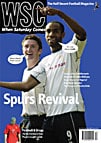 Ian Plenderleith has happy memories prompted by a shrine to Aberdeen's European heroes and toasts some hard-drinking yet non-fighting Vikings, but is distinctly unimpressed by the efforts of the G-14
Ian Plenderleith has happy memories prompted by a shrine to Aberdeen's European heroes and toasts some hard-drinking yet non-fighting Vikings, but is distinctly unimpressed by the efforts of the G-14
Certain teams capture a boy’s imagination no matter their colours or home town. I’d never been to Aberdeen by the early 1980s, but the last Scottish team to win a European trophy (the 1983 Cup-Winners Cup) boasted one of those long-lost line-ups – crammed with talented native names that never seemed to change – and rarely seemed to lose.
An excellent website called Dons In Europe documents Aberdeen’s years in Europe since 1967 through to the present day, celebrating in particular the achievements of Miller, McLeish, Strachan, Black, Harper et al on the road to beating Real Madrid on that fabled night in Sweden. (Note to younger readers: this actually happened.) “20 Years Since Gothenburg” and “Gothenburg in Pictures” spotlight the event, while other features focus on opponents from particular countries, or the number of times the Dons have fallen foul of the away-goals rule. This is deemed by the site to be “one of the daftest rules in football”, but that’s understandable given that it has meant in more recent times the club has fallen victim to both Skonto Riga and Bohemians of Dublin.
One reason I loved this side was the unlikely figure of Doug Rougvie, surely the tallest full-back ever. He ran like a virgin roller-blader on a black-iced mountain, but somehow always got the job done. In the obligatory but still fascinating “Where Are They Now?” section, we hear Doug “still plays for Kincorth Amateurs, but his day job is with Kelloggs, Brown and Root. He also appears at Pittodrie on match days, entertaining corporate guests”. You’d like to think it’s by hacking surprised businessmen to the floor on their way to the buffet.
Further investigating the subject of the British in Europe, I came across a 1996 academic journal published by the Oxford-based Social Issues Research Centre entitled Football Violence and Hooliganism in Europe. Sceptical at first, I found that if you skipped around the data, the probably outdated analysis and the verbose theorising you could find all kinds of fascinating information.
For instance, not all European hooligans were copying British Sixties role models. In the 1950s in Turkey, “fans of Kayseri and Sivas fought with pistols, knives and broken bottles for days after the end of a match between the two sides. Before troops restored order, cars were burned out, 600 spectators injured and 42 killed, 25 by stab wounds.” Which makes Dougie Brimson’s books look fit for Jackanory. Further back in time, Manchester United have been provoking negative feeling for far longer than previously supposed. Their players were attacked by fans when leaving the pitch after a friendly match in Hungary – in 1908.
The academics quoted from the Danish Sport Research institute describe that country’s roligans as if they are some sort of lost Nordic tribe. “The roligan displays a feature which links him with his counterpart, the hooligan: excessive alcohol consumption. English, Irish and Danish fans compete for the position of being the most drunk – yet fundamentally different behaviour patterns arise. Where the heavy drinking of English hooligans impels aggression and violence, the roligan is characterised by the absence of violence and companionable cheerfulness.” What? People can get pissed and enjoyed themselves? Next thing we know there’ll be an EU directive telling red-blooded Englishmen they have to fall in line.
As for a decent independent fans’ website covering the whole European game, you’ll have to search far and wide. There are dozens of sites providing results, tables and generic news feeds, but little evidence of commentary, correspondents or interesting match reports. The website of the magazine European Soccer Weekly is promising imminent “content”, but if I had a euro for every time I’ve seen that on a web page I’d be setting up a network of writers from Stockholm to Istanbul myself.
Never mind, you can bring yourself closer to the spirit of the European game with a peek at the official website of the G-14. There’s a lovely picture of Valencia president Jaime Orti Ruiz embracing David Dein. And then you can read the heart-soothing story of how the chairmen of Europe’s top clubs had “to overcome a number of obstacles” to “achieve the construction of their pioneering enterprise”. Or rather you can’t, because “the following account” doesn’t exist, which may or may not reflect the “philosophy, dynamism and vision of football” the G-14 claims to be propagating. Winner of the WWW award – World’s Worst Website.
From WSC 202 December 2003. What was happening this month